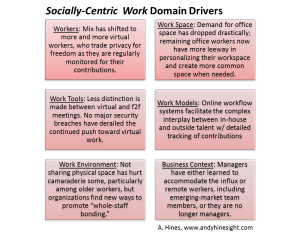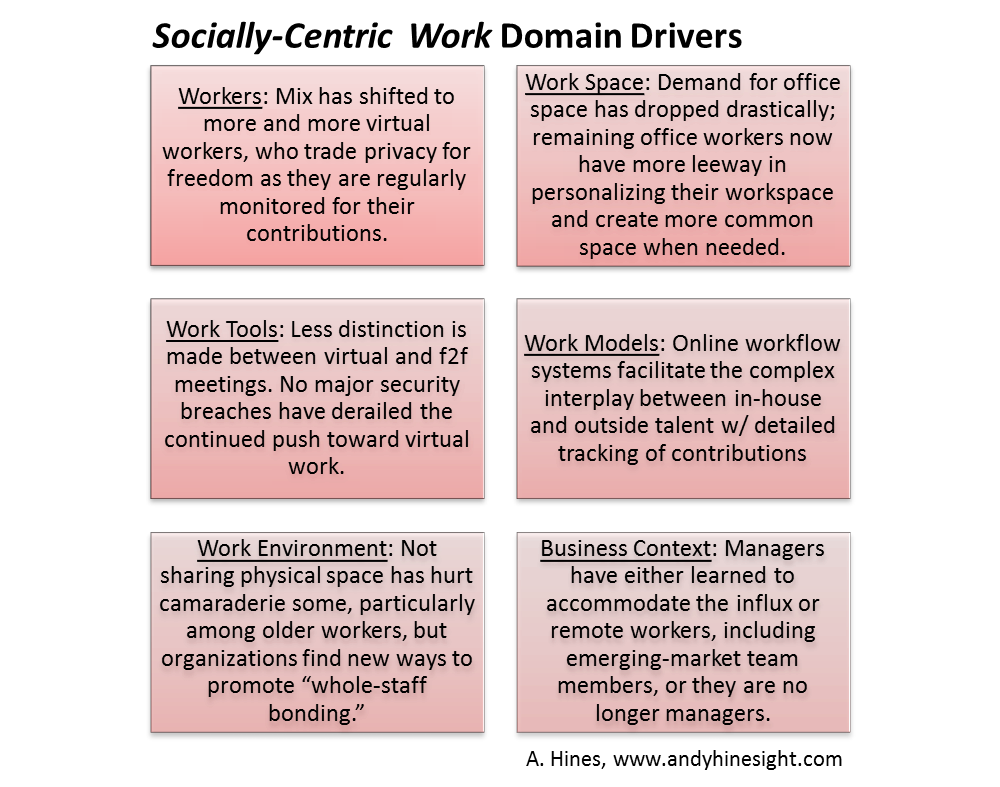Socially-Centric Work describes a “new equilibrium” scenario archetype [see description below]
Digitization and the rise of social networks create new opportunities for collaboration and for new roles and relationships, as insiders, freelancers, and even customers routinely work together. Although there were challenges during the transition, they were overcome and work has effectively reshaped around these new dynamics.
 Under the influence of cheap mobile computing, ubiquitous connectivity, and the transparency provided by social networks, the nature of work changes dramatically. It is driven not by hierarchies or credentials but by transparency and social networks that effectively match the right people to the right projects. Organizations take advantage of reduced overhead costs offered by having a virtual workforce, while workers take advantage of the convenience of working virtually or the freedom of freelancing to the highest bidder.
Under the influence of cheap mobile computing, ubiquitous connectivity, and the transparency provided by social networks, the nature of work changes dramatically. It is driven not by hierarchies or credentials but by transparency and social networks that effectively match the right people to the right projects. Organizations take advantage of reduced overhead costs offered by having a virtual workforce, while workers take advantage of the convenience of working virtually or the freedom of freelancing to the highest bidder.
But this change was not seamless, as many workers—especially boomers and older Gen Xers—struggled to adapt to this new world of work. Businesses struggled, too, and were preoccupied during the years from about 2012–2016 with lingering concerns about intellectual property leakage, corporate security, competitors poaching freelancers, and other related issues. Thankfully, these issues are all dealt with in turn. For example, companies rely on performance-feedback technologies, which help mitigate concern about the productivity and contributions of virtual workers and freelancers. And a host of new businesses and services are created to support the burgeoning freelance workforce: co-working centers, expanded “third-space” options, and digital guilds that help provide businesses with a sense that their freelancers are “credentialed,” while also helping to provide an entity to protect and fight for the rights of its members.
The knowledge work scenarios were developed using the scenario archetype approach* describes typical patterns of change in a “system” (in this usage, roughly translated as “the way things are currently done). Let’s briefly review:
- Continuation: The system moves forward along its current trajectory. This is the “official future” and usually considered most likely.
- Collapse: The system falls apart under the weight of “negative” forces.
- New equilibrium: The system reaches a balance among competing forces that is significantly different from the current balance.
- Transformation: The system is discarded in favor of a new one with a new set of rules
— Andy Hines

[…] Socially Centric Work also presents a series of challenges to knowledge work, but in this scenario they are successfully resolved, relying on a much greater integration of social networking tools to manage the transition to the world of knowledge work that goes deeper than Virtual Teams Collaborating. […]